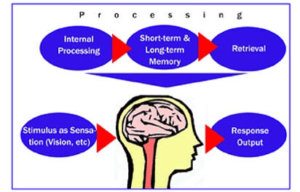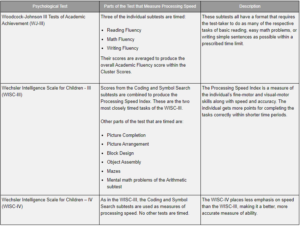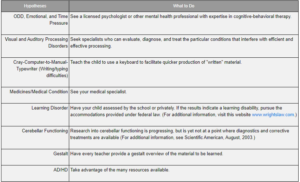This article by George W. Dorry, Ph.D. addresses some of the psychological measures of processing speed and outlines some hypotheses to explain individual cases.
Author: Dorry, G.
Publisher: 2e Newsletter
Year: December 2004
The premise is simple: some gifted people act like the tortoise and some like the hare in the ancient Aesop’s fable. The hares speed through tasks, sometimes making errors along the way; and the tortoises take their time. The characters in the fable are predisposed by their nature and physical form to do so. Why do some gifted people act like tortoises? We’ll address some of the psychological measures of processing speed (also referred to as speed of task completion or fluency), and then outline some hypotheses to explain individual cases.

What Do We Mean by Processing Speed?
Processing speed is the amount of time it takes to produce the response output once an individual has been asked to do a task.
Some children are quite intelligent and yet unable to produce the amount of output expected, given that intelligence. Sometimes we inappropriately interpret their behavior as “lazy,” or “unmotivated,” or even “oppositional.” These children may be able to produce under untimed conditions, but not do the same task well or quickly when timed. Or they may be able to respond at fast rates in some circumstances, but not when their learning or other weaknesses are required to produce the responses.
How Do We Measure Processing Speed?
Psychological tests don’t measure processing speed as it happens in the brain. We measure the observable, recordable speed on an individual task; or we look at how many tasks can be completed in a time period and infer that that measures “internal” processing speed. When we compare achievement levels measured with and without timing, there can be a significant difference between the ability to do a task well and the ability to do it quickly.
Among the now classic measures of processing speed, several are part of the most commonly used psychological tests. These are shown in the table below.

Many gifted children lose points on the timed portions of these tests because they cannot or will not perform quickly. These are often children who have a high need for achievement and who prefer to use a slower, reflective response style that decreases the probability of error. When the abilities of these children are assessed without time limits, we are likely to find that they can do the tasks, sometimes at a level well above their years.
What Tortoises Look Like
Fourteen-year-old Jack is the most marked example of the combination of giftedness and slow processing speed that the author has seen in over 25 years of assessments. Among his scores were these:
WISC-III Processing Speed Index: 91
WJ-III Timed Writing Fluency Subtest: 94
WJ-III Untimed Writing Samples Subtest: 179
The Processing Speed Index showed him to be below the average score of 100. The Woodcock-Johnson scores showed an amazing difference between the timed and untimed writing subtests: 5.67 standard deviations, or roughly the difference in height between a newborn and the average professional basketball player!
Not all children have such dramatic differences between their abilities and achievement on timed and untimed tasks and tests. The contrast between what we could expect of them if we presume consistency and the “consistent inconsistency” of their performance is at the core of processing speed difficulties.
How Do We Explain the Tortoise Phenomenon?
If you were hoping for a single benign explanation for processing speed difficulties, “abandon all hope ye who enter here.” There are many to consider. As you read the following descriptions, remember that these hypotheses are not mutually exclusive. They may be co-occurring, or they only occur in some circumstances and not in others. Also, take into account these factors: inability and intentionality. In other words, consider how much of a child’s behavior is due to the choice to go slowly and how much is the result of an inability to control processing speed.
Oppositional-Defiant (ODD) Hypothesis – may be one of two varieties:
Gandhi (passive-resistance): “You can’t make me do it!”
Che Guevara (active resistance): “Power to the people! I get to decide what I do, or don’t do!”
Both demonstrate a conscious choice to avoid or escape from performing tasks or to resist the request by authority. The result is slower performance despite the necessary intelligence. There can be a reason for that resistance other than egocentric or control issues. Many individuals develop resistance to tasks they do not do well.
Emotional Hypothesis – the result of strong emotional states such as anger, anxiety, depression, stress, elation, or fear of failure. A child’s performance speed can drop if emotions interfere with focusing or cause the child to react to the task at hand. Those who are calmer and more focused are more likely to do their best and do it quickly.
Time Pressure Hypothesis – comes from the fact that Tortoises tend to do less well on timed tests, for example, “Math Minutes.” Some children know math concepts and facts and can calculate well when not timed. If time pressure becomes a persistent issue for these students, anxiety and frustration about timed tests may increase and damage their self-esteem. Over time they come to expect poor performance and avoid timed tasks in general, posing difficulties with tests such as the SAT or ACT. (The AD/HD Hypothesis, later in this article, addresses further difficulties with functioning in time.)
Visual or Auditory Processing Disorder Hypothesis – based on the effect on processing speed that dysfunctions or developmental delays within the brain can have. Any of the input channels into the brain (e.g., vision, hearing, touch, taste) may have a relative weakness. For example, a child may have a problem with the way the eyes process visual information. One child recently assessed had a markedly low processing speed. The reason became apparent when a thorough eye exam confirmed significant visual processing problems.
Cray-Computer-to-Manual-Typewriter Hypothesis – stems from the inability to write or type fast enough to keep up with the thoughts that a gifted child wants to express. A 9-year-old complained, “My brain works much too fast for my fingers.” Given that he had the “gift of the gab,” this child usually did very well when he could respond orally, but did poorly when he had to respond in writing.
Medicine/Medical Condition Hypothesis – the result of medications or medical conditions that can slow down or increase processing speed. Many medications can influence speed of performance. For example, stimulants can speed up responses while anti-histamines can slow them down. Homeopathic and other remedies can affect processing speed as well. And as anyone who has had a cold or the flu well knows, temporary or chronic medical conditions can also adversely affect processing speed.
Learning Disorder Hypothesis – which reflects the differences in performance when a child uses areas of brain function that are strong versus those that are weak. If you test children’s processing speed on a timed task that only requires them to use areas of brain function that are strong, they will be much better able to respond quickly and accurately than if you test them on tasks that make use of an area of weak functioning.
Cerebellar Function (or Lack of Automaticity) Hypothesis – based on the fact that fluent, automatic processing of information in the cerebellum leads to fast and efficient performance. Once our cerebellum has practiced a task – like bike riding – enough, it remembers how to do it. If the cerebellum does not process the information automatically, the task must be done at a slower pace every time it’s performed.
Gestalt Hypothesis – which reflects the need of some learners who have difficulty with analysis of the “gestalt” or overview of complex visual stimuli. Difficulty with achieving a gestalt, or “big picture,” of visual stimuli makes learning more difficult for any student. It’s even more of a problem for “whole-to-part” learners who need an overview of the whole concept or schema before they can effectively incorporate it into their memory.
AD/HD Tortoise Hypothesis – which runs counter to the stereotype of individuals with Attention Deficit/Hyperactivity Disorder as being hyperactive, impulsive, and lacking self-control. The idea of individuals with Attention Deficit/Hyperactivity Disorder as tortoises seems oxymoronic. If there is an animal symbol for AD/HD, it ought to be the hare. Hyperactive and slow processing?!?
Children with AD/HD have difficulty with “internal” time monitoring. They often act as if they have no awareness of time, either acting too fast and impulsively, or too slowly when they are distracted. Those who act too fast make impulsive errors that lower their fluency and processing speed scores. Those who act too slowly – individuals with certain subtypes of AD/HD – can take too long to do a task because they get internally or externally distracted. (For additional information on this topic, see ADHD and the Nature of Self-Control by Dr. Russell Barkley, Guilford Press, 1997.)
What Comes Next?
Parents of children with slow processing speed relative to their IQ can review these hypotheses to see if they match their child’s overt behavior and inferred internal or emotional state. Teachers are a good source of input as well. Identifying the cause(s) may require the help of teachers as well as other professionals.
Once the causes of slower processing speed are identified, they can often be effectively addressed. There are no magical cures outside of Hogwart’s School, but there are specific paths towards improvement once the correct causal hypothesis or hypotheses have been identified. See the table below for a summary of these.

George W. Dorry, Ph.D. is a Licensed Clinical Psychologist who is in his 25th year of private practice specializing in the assessment, diagnosis, and treatment of AD/HD and Learning Disorders. He is the Director of the Attention and Behavior Center in Denver, Colorado. He founded the Attention and Behavior Institute, a not-for-profit organization with a mission to educate families and professionals in the USA and internationally about AD/HD and related conditions.
Permission Statement
Comments